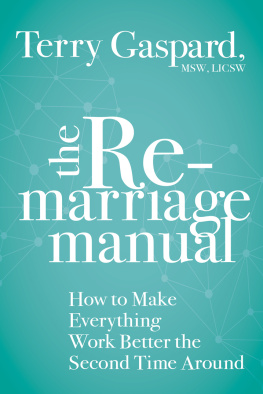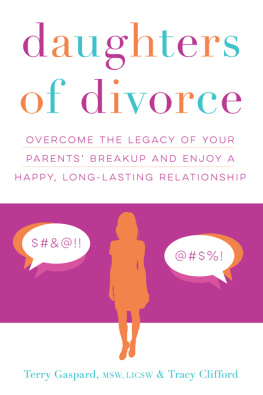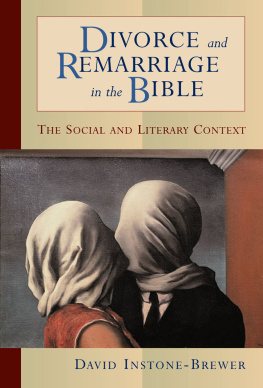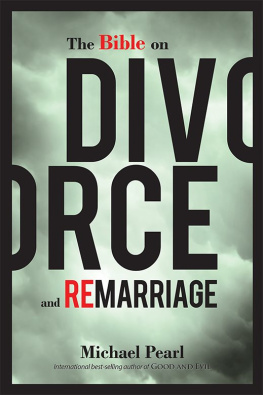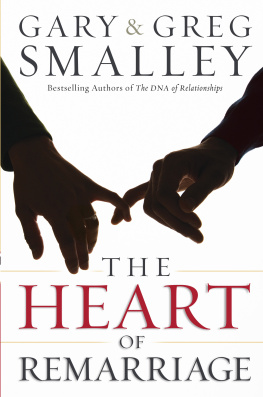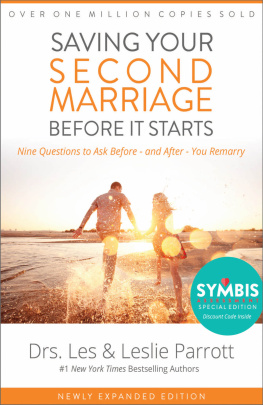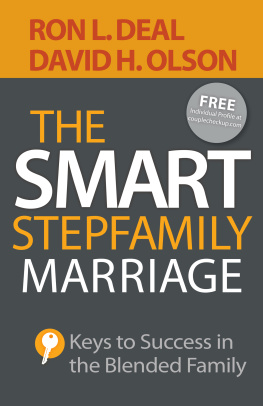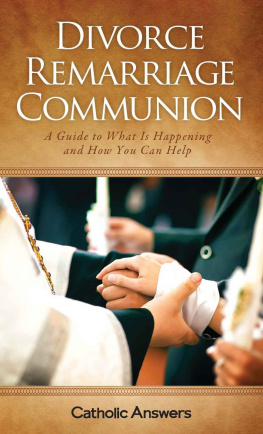Contents
Guide


To my husband, Craig, and my children,
Sean, Tracy, and Catherine,
who have given me the love, courage,
and inspiration to write this book.
Contents
Authors Note
m y interest in studying remarriage and stepfamily life began with my own experience, because I was raised in a blended family consisting of three older sisters and a younger stepbrother. My passion for this topic grew after my own divorce in 1995, and my remarriage two years later. After watching my father and stepmother navigate the challenges of a second marriage successfully for over three decades, I assumed that I was well prepared. But after going through a tough period in my own remarriage, it became obvious to me that experience isnt always the best predictor of success in marriage. As a result, I began paying more attention to the issues that the remarried couples in my practice face and looked for books and resources to support them, so they could establish healthy, happy, and long-lasting relationships. Unfortunately, the books I found were either outdated or focused on issues with stepchildren rather than giving remarried couples practical tools to help them thrive.
When I decided to write this book, I supplemented my clinical and personal experience by interviewing dozens of remarried couples who I approached through my practice, website, and referrals from colleagues. Over a period of three years, I interviewed a hundred couples who had been divorced at least once, and at least one partner had been married at least twice. The average age of participants was 43. These interviews formed the basis for The Remarriage Manual: How to Make Everything Work Better the Second Time Around.
The couples quoted in the following pages were participants in that study, and the stories told here are profiles and composites based on real people. However, names and details have been changed to protect their privacy. Details about the locations of the interviews were altered in some cases as well, for the participants protection.
Please note that this book is not meant to replace professional individual or couples therapy. Rather, it is intended to offer an in-depth chronicle of the joys and struggles of remarriage and stepfamily life and to provide concrete ways to improve and strengthen family relationships. For simplicity, the word stepfamily is often used in the book to denote both stepfamilies and blended families. In the end, it is my hope that couples reading this book will learn how to be present for each other, so they can heal from past relationships and create a truly loving and intimate bond that will endure the test of time.
Terry Gaspard, MSW, LICSW
Introduction
An Opportunity to Start Fresh
w hen couples begin a remarriage, the most frequent mistake they make is expecting that everything will fall into place and run on automatic. Love may be sweeter the second or third time around, but once the bliss of a newfound relationship wears off, the reality of joining two distinct worlds sets in. Different routines and parenting styles; financial issues; legal matters; relationships with ex-spouses, children, and stepchildren all of this can chisel away at the closeness of the remarried couple. If you havent established a strong connection and are unprepared to deal effectively with conflict and lack the tools to repair daily breakdowns in communication, you may end up pointing fingers at each other rather than being supportive.
For instance, Conner, 49, and Tara, 48, remarried for six years, take seats on opposite ends of the couch during their first counseling session with me. When I ask them about some of the challenges theyve faced in their second marriage, Conner clarifies why he feels frustrated with Tara. He also explains that he still loves Tara very much and hopes that our meetings will shed some light on how to get back to feeling good about their marriage.
Conner speaks directly to Tara and puts it like this: You seem to forget that I have to work long hours to keep us afloat. Since Michael was born three years ago, our budget is really tight. Of course I love all of the kids, but theyre expensive. And I wish youd stop comparing me to your ex. I know he betrayed you financially, but it doesnt seem like youre ever going to get over it.
Tara responds, Thats the problem. Our relationship always comes last. You dont think we have a problem even though I keep telling you how lonely I am. We havent spent time together in over a month. It seems like youre always working, just like Gary did, and never have time for me and our family.
What is at the heart of this couples disagreement? Like most remarried couples, they arent really arguing about how often they have candlelit dinners. Theyre feeling emotionally disconnected and that has created conflict. Similarly, most of the couples I interviewed for this book were looking to restore intimacy in their relationship but didnt know where to begin. They were longing to rekindle the passion and emotional connection of their early days together, before the stressors of remarried life set in. One thing is certain: you cant return to the glory days. But you can most definitely learn to cherish each other again. This starts with intentionally choosing each other daily (more on this as we continue) and letting go of the expectation of a perfect partner who will meet all your needs!
HOW THIS BOOK CAME TO BE
At the age of 42, I endured a high-conflict divorce and two years later married the love of my life. I was hopeful and optimistic about marrying Craig, confident we were more emotionally and sexually compatible than I had been with my ex and better aligned in our values and aspirations. Life had certainly thrown me some curveballs before I met my second husband, but I still believed in marriage. He swept me right off my feet and proposed four months after we started dating. It would be a second marriage for both of us. He had been married and divorced ten years earlier and had no children. I had two children, ages 9 and 11, from my previous marriage. It may sound surprising, but Craig wanted to be a stepparent, and right away we also discussed having a child together. Having a new baby and starting a stepfamily made the first several years of our marriage busy and exciting.
Eight years in, our marriage was on shaky ground. We were dealing with myriad issues common to remarriage, including co-parenting with a former spouse, unresolved emotional baggage from our first marriages, financial stress, and different parenting styles. We were also dealing with jealousy, anger, and resentment around the competing needs of children and stepchildren and the expectations of in-laws. I assumed we would be one big happy family, but Craig still often felt like an outsider with my two biological children, and we hadnt truly learned how to nurture our intimate relationship.
We argued frequently, and for many years we were unable to understand the complex dynamics unfolding before us and support each other as loving, devoted partners. We drifted so far apart that we discussed separating. Thankfully we found an excellent marriage counselor and began healing. It took time, but we fell back in love and have learned to accept each others differences, work through conflict, and repair our relationship after a dispute. Weve been remarried twenty-two years and couldnt be happier.
Sadly, were the exception.
According to experts, even though the majority of divorced people will eventually remarry, most of these marriages will fail due to the difficulties that remarried couples face building a relationship while adjusting to, and combining, existing families and complex relationship histories. Few couples understand at the outset how complicated and demanding remarriage is.
Next page
